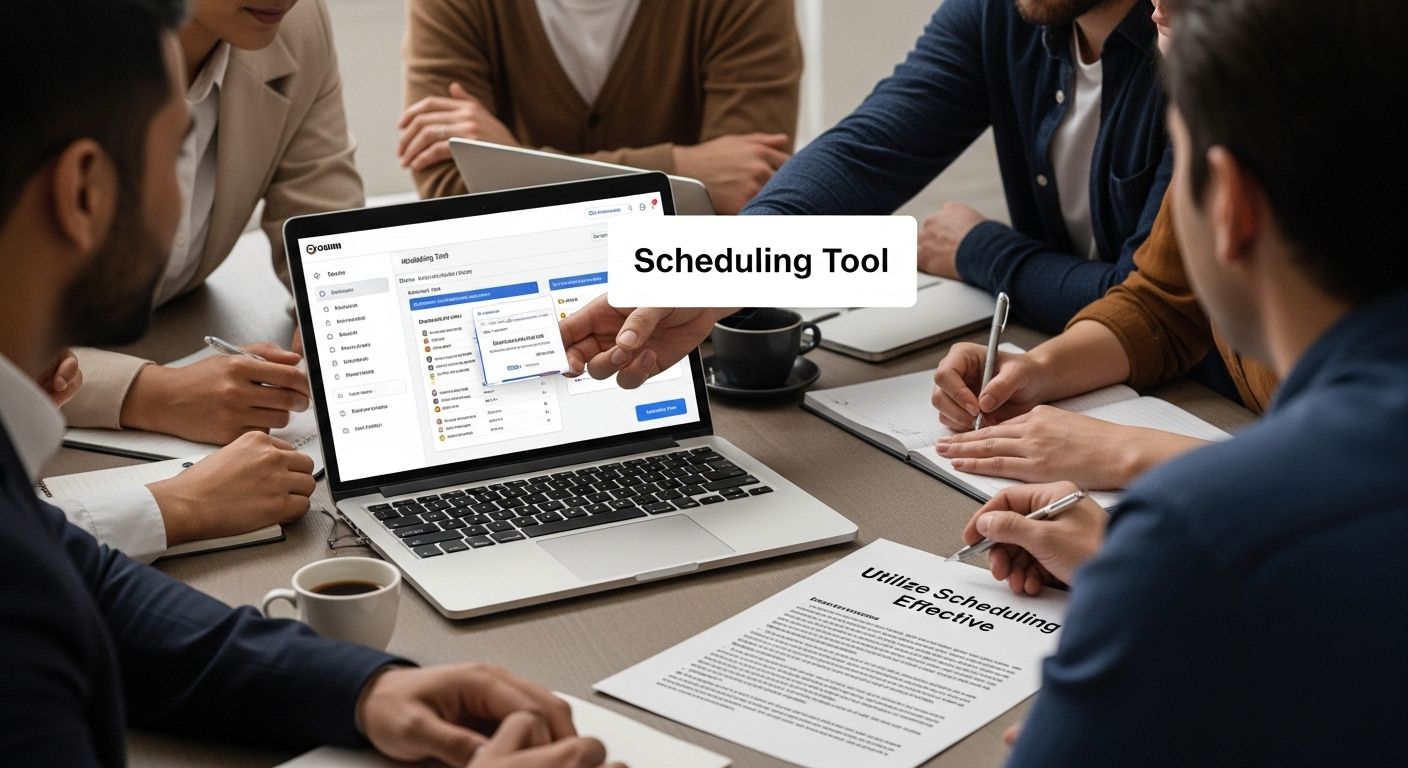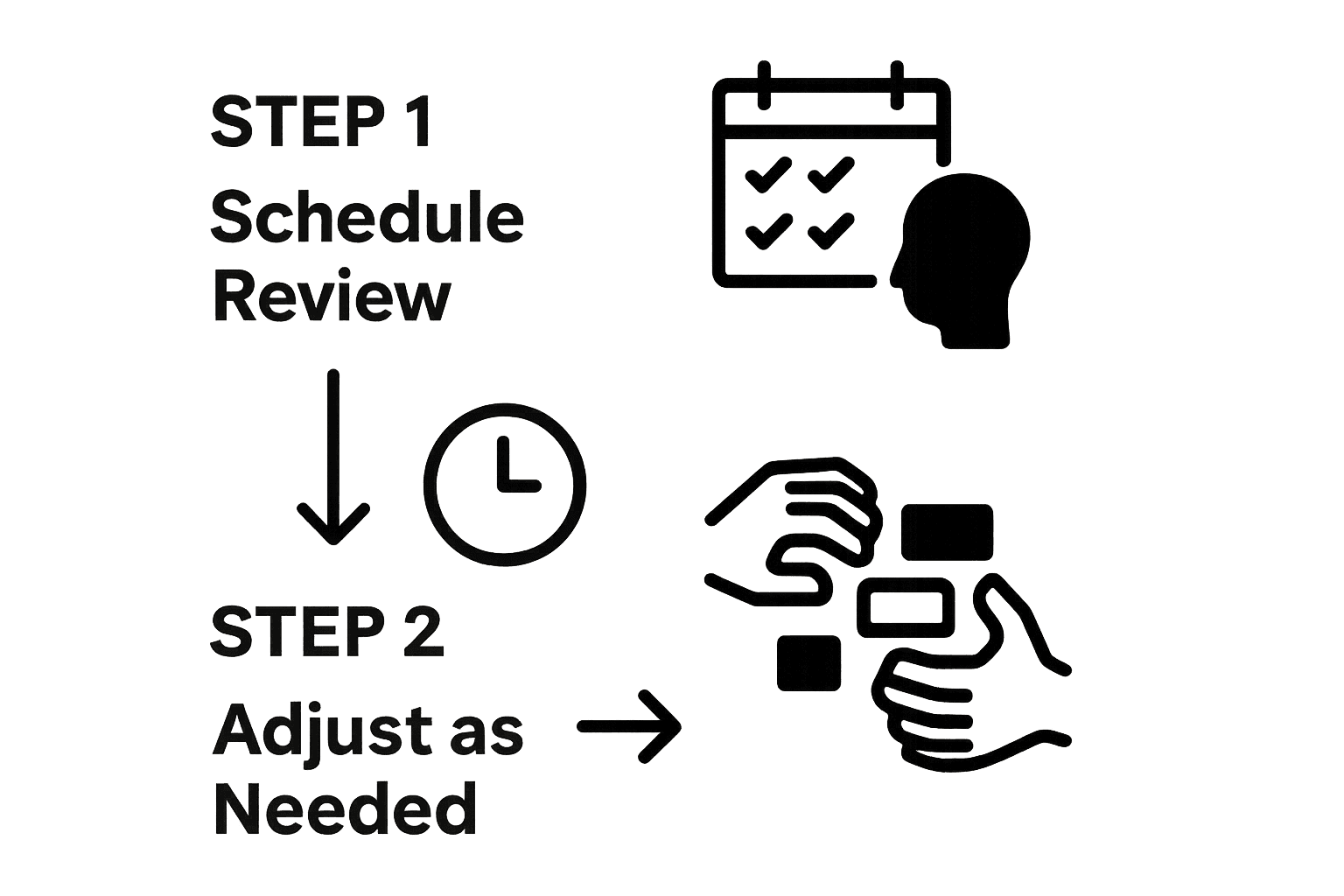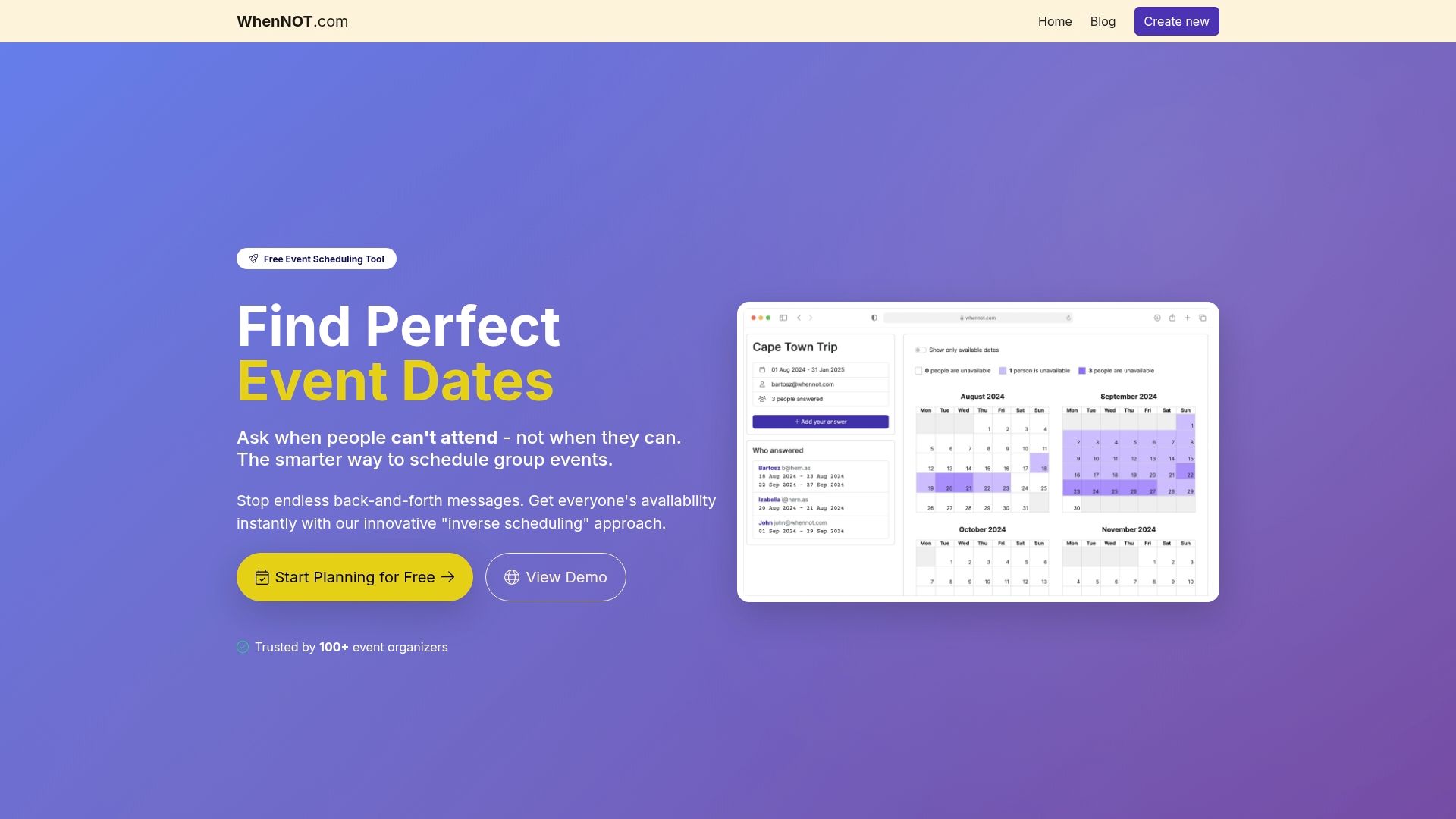Coordinating group schedules often feels like chasing moving targets. Over 70 percent of teams struggle with misaligned availability or last-minute scheduling conflicts, which leads to wasted hours and drained morale. But the usual approach—just sending more calendar invites—rarely solves the real problem. The real secret is that scheduling success actually begins before anyone even picks a date, and it has far more to do with team strategy than most people realize.
Table of Contents
- Step 1: Define Your Scheduling Objectives
- Step 2: Gather Availability From Participants
- Step 3: Utilize A Scheduling Tool Effectively
- Step 4: Propose And Finalize The Schedule
- Step 5: Communicate The Schedule Clearly
- Step 6: Review And Adjust As Necessary
Quick Summary
| Key Point | Explanation |
|---|---|
| 1. Clearly Define Scheduling Objectives | Establish specific goals to guide scheduling and optimize team performance effectively. |
| 2. Gather Availability Efficiently | Use user-friendly digital tools to collect participant availability without hassle. |
| 3. Utilize the Right Scheduling Tool | Evaluate tools based on team needs to enhance collaboration and streamline scheduling. |
| 4. Propose a Draft Schedule Openly | Present a schedule draft transparently to invite constructive feedback from team members. |
| 5. Regularly Review and Adjust Schedule | Implement feedback mechanisms to adapt schedules based on team dynamics and performance. |
Step 1: Define Your Scheduling Objectives
Defining clear scheduling objectives is the foundational step that transforms group coordination from chaotic guesswork into strategic planning. Without well-articulated goals, team scheduling becomes a complex puzzle where every piece seems disconnected and misaligned. Your scheduling objectives serve as the strategic compass that guides all subsequent planning decisions.
Start by conducting a comprehensive assessment of your team's unique requirements. This involves examining multiple dimensions beyond simple time availability. Consider the specific project goals, individual team member strengths, potential workload distribution, and anticipated challenges. Effective scheduling objectives transcend mere time allocation and focus on optimizing team performance and individual well-being.
According to CDC's Workplace Health Research Guide, organizations must articulate precise scheduling objectives that balance operational demands with employee wellness. This means looking beyond productivity metrics and understanding the human elements of scheduling. Key considerations include:
- Ensuring fair workload distribution
- Supporting individual work-life balance
- Maintaining team collaboration opportunities
- Accommodating diverse personal constraints
As you define your objectives, create a holistic framework that addresses both quantitative and qualitative team needs. Quantitative objectives might include metrics like total project hours, meeting frequency, or task completion rates. Qualitative objectives could encompass team morale, skill development opportunities, and personal growth potential.
Remember that scheduling objectives are not static documents but living strategies. They should remain flexible enough to adapt to changing team dynamics while providing a clear structural framework. Regular review and refinement of these objectives ensure that your scheduling approach remains responsive to evolving team needs and organizational goals.
Successful objective definition means you can confidently answer questions like: What are we trying to achieve? How will this schedule support our broader team and organizational mission? By maintaining clarity and purpose, you transform scheduling from a mundane administrative task into a strategic tool for team optimization.
Step 2: Gather Availability from Participants
Gathering participant availability represents the critical bridge between scheduling objectives and actual event coordination. This step transforms abstract planning into concrete scheduling by collecting detailed input from each team member or participant. The key is creating a streamlined process that minimizes friction and maximizes comprehensive data collection.
Begin by selecting a communication method that ensures maximum participation and convenience. Digital tools have revolutionized availability gathering, offering multiple channels like shared online calendars, dedicated scheduling platforms, and collaborative spreadsheets. Prioritize methods that require minimal effort from participants while capturing precise availability details.
According to Cornell University's Workplace Collaboration Research, successful availability gathering depends on clear communication and user-friendly submission processes. This means providing explicit instructions, setting reasonable response deadlines, and offering multiple submission options to accommodate different participant preferences and technological comfort levels.
Consider implementing a tiered approach to availability collection. Start with broad time ranges or potential date blocks, then progressively narrow down options as participants provide input. This strategy reduces decision fatigue and increases the likelihood of comprehensive responses. Some effective techniques include:
- Sending initial availability request with multiple potential time blocks
- Providing a clear deadline for response
- Offering a simple, intuitive submission mechanism
- Following up personally with participants who haven't responded
Technology can significantly streamline this process. Modern scheduling platforms allow participants to indicate their availability without extensive manual input. Look for tools that enable quick marking of busy and free periods, integrate with personal calendars, and provide real-time collaboration features.
Verify the completeness of your availability data by checking for consistent participant engagement. A successful availability gathering step means you have received input from all critical team members, with comprehensive information about their potential constraints and preferences.
This table compares common methods for gathering team availability, outlining their advantages and potential limitations for streamlined selection.
| Method | Advantages | Limitations |
|---|---|---|
| Shared Online Calendar | Real-time updates, easy access | May require setup and tech comfort |
| Scheduling Platforms | Simple input, automated features | Potential learning curve, privacy concerns |
| Collaborative Spreadsheet | Customizable, familiar format | Manual updates needed, version control issues |
| Email Request | Universal access, no tools needed | Prone to missed responses, manual collection |
| Pay attention to patterns of non-response, which might indicate communication barriers or participant disengagement that need additional attention. |
Remember that availability gathering is more than a mechanical data collection process. It's an opportunity to demonstrate respect for participants' time and build collaborative momentum for your upcoming event or project.
Step 3: Utilize a Scheduling Tool Effectively
Effective scheduling tool utilization transforms complex coordination challenges into streamlined, manageable processes. The right scheduling tool acts as a strategic command center that bridges individual availability with collective objectives. This step is about more than simply selecting a platform it is about mastering a digital ecosystem that enhances team communication and efficiency.
Begin by thoroughly evaluating potential scheduling tools against your specific team requirements. Not all tools are created equal, and the most expensive or popular option might not align with your unique needs. Consider factors like user interface intuitiveness, integration capabilities with existing team systems, privacy features, and scalability. A tool that feels natural and requires minimal learning curve will generate higher team adoption and more accurate scheduling results.
According to Medical Internet Research on Digital Collaboration Tools, successful digital scheduling depends on comprehensive feature assessment and strategic implementation. This means looking beyond basic calendar sharing and examining advanced capabilities like:
- Automated conflict detection
- Real-time collaboration features
- Customizable permission settings
- Cross-platform accessibility
- Robust data privacy protections
Implementation requires a thoughtful, phased approach. Introduce the scheduling tool gradually, starting with a pilot group or specific project. Provide clear training resources and support to ensure team members feel comfortable navigating the new system. Create short video tutorials, host brief onboarding sessions, and designate a tool champion who can answer questions and provide ongoing guidance.
Maintain flexibility in your tool usage. While structured processes are important, overly rigid scheduling systems can create friction. Encourage team members to provide feedback about the tool's functionality and be prepared to make adjustments. The most effective scheduling tools evolve with your teams changing dynamics and requirements.
Verify successful tool implementation by monitoring key metrics like user engagement, scheduling accuracy, and time saved in coordination efforts. A well-utilized scheduling tool should reduce communication overhead, minimize scheduling conflicts, and provide transparent visibility into team availability and commitments. By treating the scheduling tool as a dynamic collaborative platform rather than a static administrative system, you unlock its full potential for team optimization.

Step 4: Propose and Finalize the Schedule
Proposing and finalizing a schedule represents the critical moment where collective availability transforms into a concrete plan. This step is the pivotal bridge between potential time slots and confirmed commitments, requiring diplomatic negotiation and strategic decision making.
Initiate the proposal process by presenting a draft schedule that transparently reflects the availability data collected in previous steps. Transparency is key approach this stage as a collaborative negotiation rather than a unilateral declaration. Communicate the rationale behind proposed time selections, highlighting how the schedule balances individual constraints with overall team or project objectives.
According to National Institutes of Health Research on Group Scheduling, successful schedule finalization depends on creating robust feedback mechanisms. This means developing a proposal presentation that invites constructive input while maintaining clear decision making parameters. Consider implementing a structured review process that allows participants to:
- Provide specific feedback on proposed time slots
- Indicate critical conflicts or constraints
- Suggest alternative configurations
- Understand the broader context of scheduling decisions
During the negotiation phase, maintain flexibility without compromising core scheduling objectives. Some participants may have more rigid constraints, while others might offer greater adaptability. Your role is to find creative compromises that accommodate diverse needs. This might involve exploring alternative meeting formats like hybrid options, staggered participation, or rotating time slots that distribute inconvenience equitably.
Documentation becomes crucial in this stage. Formally record all proposed schedules, participant feedback, and final decisions. Create a clear audit trail that demonstrates how the final schedule emerged from collaborative input. This approach not only ensures transparency but also provides a reference point for future scheduling efforts.
Verify schedule finalization by obtaining explicit confirmation from all key participants. Look for clear, affirmative responses rather than passive acceptance. A successfully finalized schedule will have universal understanding, minimal residual conflicts, and a sense of collective ownership.
Below is a table summarizing the main steps for mastering team scheduling, along with the primary objective and a quick verification method for each stage.
| Step | Primary Objective | Verification Method |
|---|---|---|
| Define Scheduling Objectives | Establish clear, actionable goals | Objectives documented and reviewed for clarity |
| Gather Availability | Collect complete participant input | Comprehensive responses from all key members |
| Utilize Scheduling Tool | Enhance collaboration and accuracy | Increased engagement and reduced scheduling errors |
| Propose & Finalize Schedule | Secure consensus through negotiation | Explicit confirmations from participants |
| Communicate Schedule | Ensure team-wide clarity | Prompt acknowledgments and minimal clarification questions |
| Review & Adjust | Maintain schedule agility | Regular feedback and improvement in KPIs |
| The goal is not just agreeing on times but creating a schedule that feels fair, purposeful, and aligned with the team's broader mission. |
Step 5: Communicate the Schedule Clearly
Communicating a schedule is far more than simply transmitting dates and times. This critical step transforms a complex coordination effort into a living, actionable plan that resonates with every participant. Effective communication bridges the gap between scheduling mechanics and genuine team understanding.
Begin by crafting a communication strategy that considers the diverse communication preferences and needs of your team members. Some individuals prefer detailed written documentation, while others respond better to visual representations or concise summaries. Develop a multi-layered communication approach that provides information through multiple channels to ensure comprehensive comprehension.
According to Boston University's Remote Team Communication Guide, successful schedule communication requires intentional, strategic planning. This means going beyond basic information sharing and creating a communication framework that builds clarity, trust, and collective alignment.
Consider implementing a comprehensive communication strategy that includes:
- Sending an initial detailed schedule overview
- Providing individual calendar invites
- Offering a summary document with key highlights
- Creating a shared reference point for all participants
Technology offers powerful tools for schedule communication. Utilize collaborative platforms that allow real-time updates, integrate with personal calendars, and provide instant notification mechanisms. These digital solutions minimize communication friction and ensure that every team member has immediate access to the most current scheduling information.
Remember that communication is a two way process. Encourage participants to ask questions, seek clarification, and provide feedback about the proposed schedule. Build in mechanisms for ongoing dialogue that allow for minor adjustments and demonstrate your commitment to collective understanding. This approach transforms schedule communication from a passive information transfer into an active, collaborative engagement.
Verify the effectiveness of your communication by monitoring participant responses and comprehension. Look for clear indicators like prompt acknowledgments, minimal follow up questions, and a shared sense of schedule ownership. A successfully communicated schedule will feel less like an administrative requirement and more like a mutually understood plan that supports the team's broader objectives.
Step 6: Review and Adjust as Necessary
Reviewing and adjusting your schedule is not a sign of failure but a testament to organizational agility and responsiveness. This final step transforms your initial scheduling plan from a static document into a dynamic, living strategy that adapts to real world complexities. Successful teams understand that schedules are tools designed to support performance, not rigid constraints that hinder progress.
Initiate the review process by establishing clear, objective metrics for schedule effectiveness. These metrics should encompass more than just logistical compliance they should reflect team productivity, individual satisfaction, and overall project momentum. Create a feedback mechanism that captures both quantitative performance data and qualitative team member experiences.
According to Shift Scheduling Research on Workforce Adaptability, continuous schedule evaluation is critical for maintaining organizational resilience. This means developing a proactive approach to identifying potential scheduling friction points before they escalate into significant challenges.
Implement a comprehensive review strategy that includes:
- Collecting periodic team feedback
- Analyzing schedule adherence and performance metrics
- Identifying recurring scheduling challenges
- Documenting proposed modifications
Technology can significantly streamline the review and adjustment process. Utilize scheduling tools with built in analytics that provide real time insights into schedule performance. These platforms can help you track metrics like meeting attendance, task completion rates, and individual workload distribution. Look for patterns that suggest systemic scheduling inefficiencies and be prepared to make data driven adjustments.
Maintain a collaborative approach to schedule refinement. Frame adjustments as collective problem solving opportunities rather than top down mandates. Encourage team members to share insights about what is working well and where they experience scheduling challenges. This approach not only generates more nuanced improvements but also reinforces a culture of mutual accountability and continuous improvement.
Verify the effectiveness of your review process by monitoring key performance indicators and team sentiment. A successful review and adjustment approach will result in increased team flexibility, reduced scheduling friction, and a sense of shared ownership over the scheduling strategy.
 Remember that the goal is not perfect schedules but progressively more intelligent and responsive scheduling mechanisms.
Remember that the goal is not perfect schedules but progressively more intelligent and responsive scheduling mechanisms.
Stop Wasting Time on Endless Group Scheduling Loops
Are you feeling stuck gathering everyone’s availability, only to get bogged down in conflicts, follow-ups, and rework? This article showed how complex scheduling can quickly drain team momentum—especially when you’re juggling shifting calendars, unclear objectives, and missed connections. If communication delays or repeated information requests are causing you stress, it’s time to simplify your coordination process.

Experience a smarter way to schedule with WhenNOT. Instead of chasing responses, our platform lets you collect everyone’s busy dates up front—so you can instantly see the best options for your event. Enjoy privacy, hassle-free participation, and no complicated sign-ups. Make your next meeting or group event easy and frustration-free. Try WhenNOT’s free, user-friendly scheduling tool today and see results from the very first plan!
Frequently Asked Questions
What are the key objectives I should define for team scheduling?
Establish clear scheduling objectives by assessing your team's unique requirements, focusing on optimizing performance, ensuring fair workload distribution, supporting work-life balance, and maintaining collaboration opportunities.
How can I effectively gather availability from team members?
Use user-friendly digital tools such as shared calendars or scheduling platforms to collect availability data. Provide clear instructions, set reasonable deadlines, and follow up with participants to maximize responses.
What factors should I consider when selecting a scheduling tool?
Evaluate scheduling tools based on user interface, integration capabilities, privacy features, scalability, and advanced capabilities like conflict detection and real-time collaboration to find the best fit for your team's needs.
How can I communicate the finalized schedule effectively?
Develop a multi-layered communication strategy that includes detailed overviews, individual calendar invites, and shared reference points. Encourage ongoing dialogue to ensure clarity and mutual understanding among all participants.
